Introduction
When you walk into the cinema, have you ever thought that the traditional projector will be replaced by a brand-new technology one day?
Le Écran d'affichage LED is quietly changing the way we watch movies. Can it really completely replace the traditional projector? What are its advantages?
Table des matières
1. What are the limitations of traditional projectors?
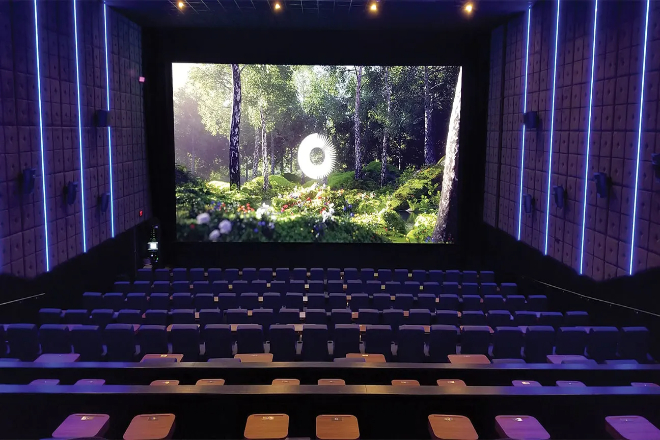
Traditional projectors use optical projection technology and rely on light bulbs to emit light. However, the brightness of light bulbs will gradually dim after a long time of use.
After hundreds of hours of use, the brightness may be reduced by 30% or even half, and the picture will become dimmer and dimmer, greatly reducing the viewing experience.
Moreover, the resolution of traditional projectors is not high.
The limitations of the optical system and imaging components make it impossible for them to display high-definition or even ultra-high-definition pictures like modern digital projectors.
The details look particularly blurred and grainy on the large screen.
The life of the bulb is also very short. Generally, it has to be replaced after 1,000 to 3,000 hours. For those cinemas that are used every day, the bulb may have to be replaced every few months.
This not only increases the cost but also is very troublesome because you need to find a professional to replace the bulb.
The optical system and mechanical parts of the projector also need to be maintained regularly.
The lens needs to be cleaned, the optical elements need to be calibrated, and the mechanical parts need to be replaced when they are worn.
These all require professional tools and equipment, and the maintenance cost goes up all of a sudden.
The traditional projector is indeed a bit unsatisfactory in terms of picture quality and colour.
In terms of contrast, it is difficult to handle the light and dark parts well. The black parts are not dark enough, and the bright parts are easily overexposed.
The picture has no sense of layering, especially those scenes with strong light and dark contrast, which are particularly uncomfortable to watch.
The colour saturation is not good, either. The colour is presented by optical filters and the spectrum of the bulb. As a result, the colour looks very bland and not bright enough.
For example, when watching natural scenery or cartoons, those pictures that should be colourful will appear particularly “plain” when played by traditional projectors.
Moreover, the uniformity of the picture of traditional projectors is also difficult to guarantee, and the edges are prone to dark corners or blurs.
Dark corners mean that the edge of the picture is much darker than the middle, and blur means that the edge part looks unclear.
These problems greatly reduce the quality of the entire picture, and the viewing experience is naturally not good.
Traditional projectors have particularly stringent requirements for the projection environment.
First of all, it requires a completely dark environment to make the picture look clear because its brightness is relatively low.
If there is light in the environment, the picture will be “flooded”, and the audience can’t see the content clearly.
This requires the theatre to install thick blackout curtains and seal the doors and windows well, which increases the construction and operation costs of the theatre.
In addition, the projection distance and angle of traditional projectors are also limited. If the projection distance is too short or too long, the picture will be distorted or blurred.
If the projection angle is not right, the picture quality will also be affected. During installation and debugging, the projection distance and angle must be accurately calculated.
The process is particularly complicated and requires professional personnel to operate.
If the installation location is not suitable, the equipment must be readjusted, which wastes time and energy.
2. Analysis of the advantages of LED display screens in cinemas
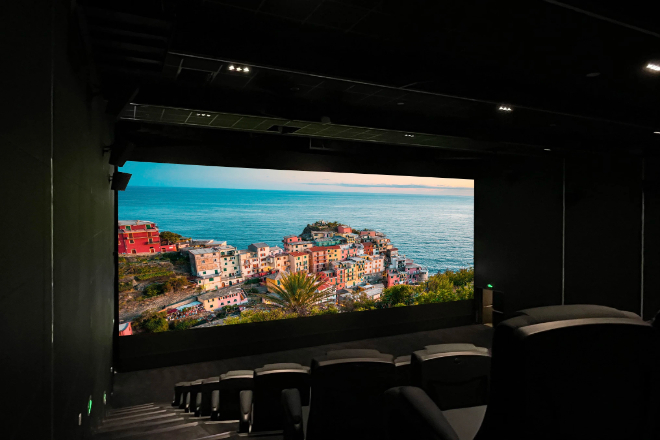
Imagine that you are watching a movie in a movie theatre, and suddenly, the lights come on, but the picture is still clear. This is the charm of an LED display!
Le luminosité of traditional projectors is not enough, and the picture is easy to dim, but the brightness of the LED display is amazingly high, which can easily reach twice or even more than that of traditional projectors.
In addition, the contrast is also super powerful. The contrast of traditional projectors is like black and white photos, and the layering is not enough, while the contrast of LED display can make the black of the picture blacker, the white whiter, and all the details can be seen clearly.
For example, when watching the dark scenes of “Batman”, the traditional projector may not let you see anything clearly, but the LED display can let you see every expression of Batman clearly, which is a great experience!
The colour in the movie is very important. Otherwise, the picture will be as ugly as a faded photo.
The LED display is particularly powerful in this regard, and it can restore the most realistic colours in the movie.
The colour gamut of traditional projectors is narrow, and the colours look a bit “grey”, but the LED display supports a wide colour gamut, and the colours are as bright as if they were just taken off the canvas.
For example, when watching the fantasy blue planet in “Avatar”, traditional projectors may make you feel that the colours are a bit fake, but LED displays can make you feel like you are on Pandora, with natural and realistic colours.
Moreover, no matter where you are in the theatre, the colours look the same, which is difficult to achieve with traditional projectors.
HDR technology is like adding a “super filter” to the picture so that the light and dark details of the picture can be perfectly presented.
Traditional projectors are a bit powerless in this regard, and the highlights are prone to overexposure, and the details of the dark parts are easily lost.
However, the HDR technology of LED displays can make the highlights of the picture sparkle, and the details of the dark parts can also be clearly seen.
For example, when watching the high-speed racing scenes in “Fast and Furious”, traditional projectors may make you feel that the picture is a bit blurry。
But LED displays can let you see every flying spark and the texture of the wheels clearly, and this sense of detail is simply irresistible!
In traditional cinemas, viewers sitting in the corner may feel that the picture is distorted or the colour is wrong.
However, the wide angle de vue of the LED display solves this problem. Its viewing angle can reach 160° or even wider, almost covering the entire theatre.
This means that no matter where you sit, the picture looks equally good.
For example, in a large theatre, the audience sitting in the last row can also enjoy the same viewing experience as the audience in the front row. This feeling of “golden seats for the whole audience” is great!
When watching a movie, the most uncomfortable thing is the picture freeze or blur.
Le haut fréquence de rafraîchissement of the LED display is like adding a “smoothing agent” to the picture, making the picture smooth like silky chocolate.
The refresh rate of traditional projectors is relatively low, and fast-moving scenes are prone to ghosting, but the high refresh rate of LED displays can keep the picture clear and smooth.
For example, when watching the superhero battle scene in “Avengers”, the traditional projector may make you feel that the picture is a bit stuck.
However, the LED display can make every move of the superheroes clearly visible, and this sense of smoothness takes the viewing experience to a higher level.
Traditional projectors require a dedicated projection room, which takes up a lot of space.
However, LED display screens can be installed directly in the theatre without the need for an additional machine room, and the space utilization is more flexible.
For example, the theatre can add a few more rows of seats to increase box office revenue.
Moreover, LED display screens can be installed on walls or ceilings and can be flexibly arranged according to the needs of the theatre. This flexibility makes the theatre’s space utilization more efficient.
LED display screens can not only play movies but also do many other things. For example, it can be used to host e-sports competitions, corporate events, live concerts, and even play advertisements.
In this way, the theatre can make money during non-movie viewing time and become a multifunctional commercial complex.
For example, e-sports competitions can be held on weekends to attract young audiences.
On weekdays, the venue can be rented to companies for activities to increase revenue.
This multifunctional feature makes the theatre’s operation more diversified and more competitive.
3. What is the current status of LED display screens in cinemas?
Now, LED display screens are no longer a rare thing in cinemas.
As early as 2018, Samsung opened the first Samsung Onyx LED Cinema in Shanghai.
Its ultra-clear 4K picture quality, high luminosité and high contrast have brought a shocking experience to the audience.
Since then, the application of LED display screens in cinemas around the world has gradually increased.
As of mid-November 2024, more than 100 LED movie screens have been installed worldwide, of which 54 were installed in 2024.
These screens not only cover a variety of sizes and specifications but are also widely used in cinemas in different countries and regions.
Among the more well-known cinemas are:
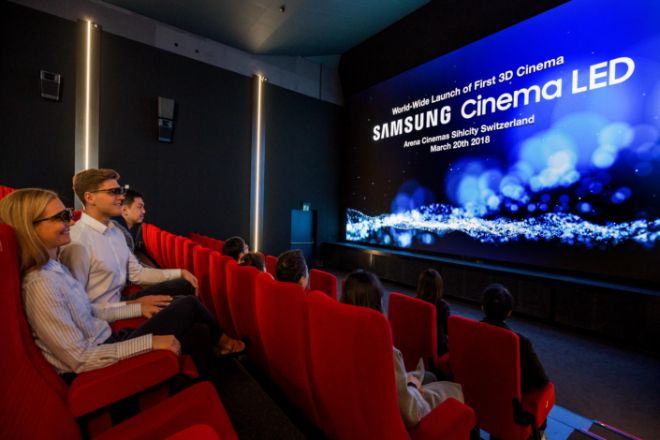
1). Samsung Onyx LED Cinema:
Samsung is a “leader” in this regard. The Onyx LED screen they developed not only has ultra-clear pictures but also has great sound effects.
For example, in some cinemas in Paris and the United States, audiences sit there watching movies and feel like they are in the scene.
This kind of screen is particularly suitable for special effects blockbusters, such as “Avatar”, where the details in the picture can be seen clearly.
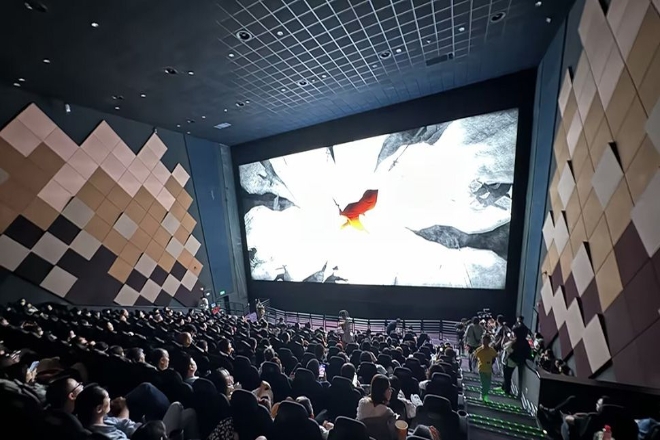
2). Lopu fully sound-transparent LED movie screen:
Lopu’s screen is also very powerful. It is not only sound-transparent but also perfectly cooperates with the sound system.
When the audience sits in the theatre, they can not only see super clear pictures but also hear stereo sounds coming from all directions. This experience is simply too cool.
In addition, in North America and Europe, the audience and theatre owners have always been very receptive to new things, so the promotion of LED display screens has progressed quite smoothly here.
For example, in the United States and France, some theatres have already started using this kind of screen, and the audience feedback is particularly good.
They all say that this kind of screen has raised the viewing experience to a higher level.
Asia is not far behind, and China and South Korea are also promoting it very quickly. China now has many theatres using LED screens, and the number is still increasing.
As an “old player” in LED technology, South Korea has spared no effort in promoting this kind of screen, not only leading in technology but also in application.
As for places like South America and Africa, although they are not used much at present, as the technology becomes more and more mature and the price becomes more and more affordable, it is estimated that it will be used slowly in the future.
In general, the application of LED screens in cinemas is developing rapidly. Although it is not used in many places now, it will definitely become more and more popular in the future.
4. Comparative analysis of LED screens and projectors
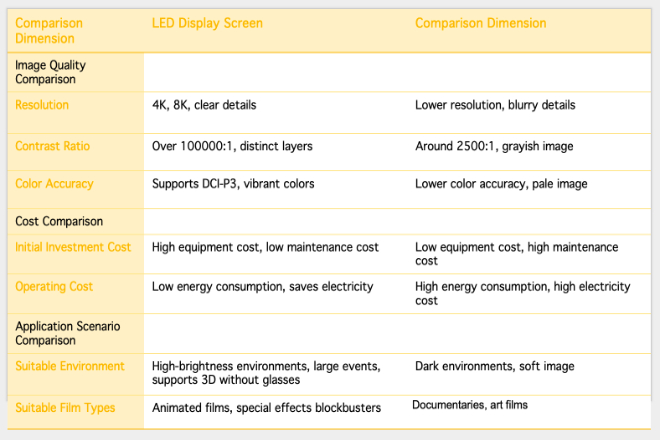
1). Comparaison de la qualité de l'image
Let’s talk about picture quality first, which is what the audience cares about most.
The gap between LED screens and traditional projectors in this regard is like the difference between high-definition TVs and old-fashioned TVs.
1.1). Résolution :
The resolution of LED screens is amazingly high; 4K and 8K are optional, and the picture details are extremely clear.
For example, when watching “Avatar 2”, the corals and fish schools in the underwater world can be seen clearly in every detail.
Although traditional projectors can also play movies, the details are a bit “fuzzy”, and the picture is not so delicate.
1.2). Contraste:
The contrast of LED screens is simply amazing, reaching 100000:1 or even higher. The black of the picture is blacker, the white is whiter, and the layering is particularly strong.
The contrast of traditional projectors is generally only about 2500:1, and the picture looks a bit “grey”, especially in dark scenes.
For example, in Gotham City at night in “Batman”, traditional projectors may not let you see the details, but LED display screens can let you see every expression of Batman clearly.
1.3). Color reproduction:
LED display screens support DCI-P3’s wide colour gamut, with super high colour reproduction, and the colours in the movie can be perfectly presented.
For example, the blue skin and fantasy plants of Pandora in “Avatar” are so colourful that they seem to be right in front of you.
The colour reproduction of traditional projectors is worse, and the picture looks a bit “light” and not vivid enough.
It is also very obvious when watching movie clips.
For example, in the racing scene in “Fast and Furious”, the high refresh rate of the LED display screen makes the picture smooth like silky chocolate, and every movement of the wheel can be seen clearly.
Traditional projectors may have a little smear, and the picture is not so smooth.
For example, in the universe starry sky in “Interstellar”, the LED display screen can make every star clearly visible, while the traditional projector may be a bit blurry.
2). Cost comparison
Let’s take a look at the cost again, which is what the theatre owner cares about most.
2.1). Initial investment cost:
The equipment price of LED display screens is not cheap, and it may cost hundreds of thousands or even millions of yuan.
However, its advantage is that it has a low long-term maintenance cost and a long life. There is basically no need to change bulbs, and it is easy to maintain.
Traditional projector equipment is relatively cheap, and a set can be done for tens of thousands of yuan.
But the bulb life is short, and it needs to be replaced after a few hundred hours of use. Maintenance costs are high, and they are also considerable in the long run.
2.2). Operating cost:
LED display screen has low energy consumption and can save a lot of electricity bills. Traditional projectors have relatively high energy consumption, and electricity bills are also a considerable expense in the long run.
For example, a medium-sized cinema can save tens of thousands of electricity bills a year with LED display screens, which is not a small amount.
3). Application scenario comparison
Finally, let’s talk about the application scenario, which is the “battlefield” of LED display screens and traditional projectors.
3.1). LED display screen:
High brightness, suitable for high-brightness environments and large-scale events. For example, in outdoor concerts and live sports events, the audience can see clearly even in the sun.
Moreover, LED display screens can also achieve naked-eye 3D effects, which is particularly suitable for showing special effects blockbusters, such as “Avatar 2”, where the audience can feel a strong visual impact.
3.2). Traditional projectors:
More suitable for the dark environment of traditional cinemas, the picture is soft, and the audience does not feel tired.
For example, when watching art films in a small theatre, the picture quality of traditional projectors can also make people feel comfortable.
In different types of films, LED display screens have obvious advantages when playing cartoons and special effects blockbusters.
For example, in cartoons such as “Nezha 2”, LED display screens can make the picture colours more vivid and the details richer.
Traditional projectors also perform well when playing documentaries that do not require so much colour and detail.
For example, natural scenery documentaries such as “Planet Earth” and the picture quality of traditional projectors can also make the audience feel the charm of nature.
5. What changes have LED screens brought to the film industry?
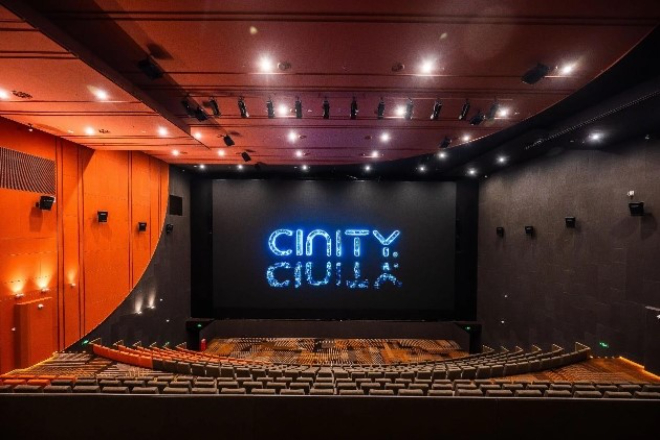
1). Impact on content creation
The film production team now has to think carefully about the high resolution and high contrast of LED screens.
In the past, when making movies, the details and colours of the picture might be just enough, but now it is not possible.
For example, in the filming of “Avatar 2”, director Cameron had to strive for perfection from shooting to post-production in order to present the best effect on the LED screen.
High resolution allows every hair and every leaf in the picture to be seen clearly, and high contrast makes the light and dark levels of the picture richer.
This requires the production team to pay more attention to details during shooting and spend more time in post-production.
Moreover, LED screens provide a very broad space for the creation of special effects movies and immersive movies.
In the past, special effects movies may not be perfectly presented due to picture limitations, but now, with LED screens, the special effects scenes in the movie can be made more realistic and shocking.
For example, in the universe starry sky in “Interstellar”, the audience can see more details on the LED screen, as if they are travelling in the universe.
This technological advancement has given the film production team more room to play and allowed the audience to see more exciting movies.
2). Improved viewing experience
The immersive and realistic feeling brought by the LED display has changed the audience’s expectations of movies.
In the past, when watching movies, the audience might just sit there and watch the pictures and listen to the sounds, but now it is different.
For example, when watching “Fast and Furious” on the LED screen, the high-speed racing scene can give the audience a strong visual impact, as if they were racing in a car.
This immersive feeling makes the audience’s expectations for the movie higher, and everyone hopes to see more realistic and shocking pictures.
Moreover, the LED display provides theatres with a variety of viewing modes.
For example, in interactive viewing, the audience can participate in the interactive links in the movie through mobile phones or on-site equipment, such as voting to decide the direction of the plot.
There is also multi-screen linkage, with multiple screens in a theatre, and the audience can watch the movie from different angles.
This novel viewing mode gives the audience more choices and makes watching movies more interesting.
3). Innovation of theatre operation mode
The LED display supports a variety of content formats, which can bring a lot of new income to theatres.
For example, for advertisements, cinemas can play high-definition advertisements before screenings to attract the audience’s attention.
Live broadcasts are no problem, either. Sports events and concerts can be broadcast live through LED screens, and audiences can enjoy a live experience in the cinema.
There are also e-sports. Cinemas can hold e-sports competitions to attract young audiences. These new content forms not only increase the income of cinemas but also make cinemas more diversified.
Moreover, LED screens have changed the layout and design of cinemas. In the past, cinemas had to reserve a special projection room and consider the projection distance and angle. Now, with LED screens, there is no need to worry about them.
Cinemas can flexibly design theatres according to needs, such as adding seats and setting up different viewing areas.
This flexible layout makes the space utilization of cinemas more efficient and provides audiences with a more comfortable viewing environment.
In short, LED screens not only make movies better but also make watching movies more interesting and fun. It not only changes the filmmaking and viewing experience but also brings new ideas and opportunities to cinema operations.
6. Conclusion
From picture quality to experience, from cost to operation, LED screens are bringing unprecedented changes to the film industry. It not only makes the viewing experience more shocking but also brings more possibilities to cinema operations.
The era of traditional projectors may be fading away, but the future of LED displays has just begun.
Enfin, si vous souhaitez en savoir plus sur les écrans LED, merci de nous contacter.
Vous pourriez être intéressé par :
Other articles about cinema LED display:
